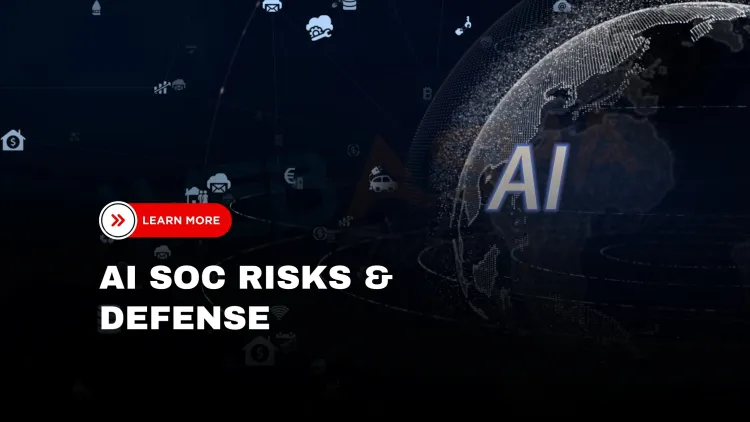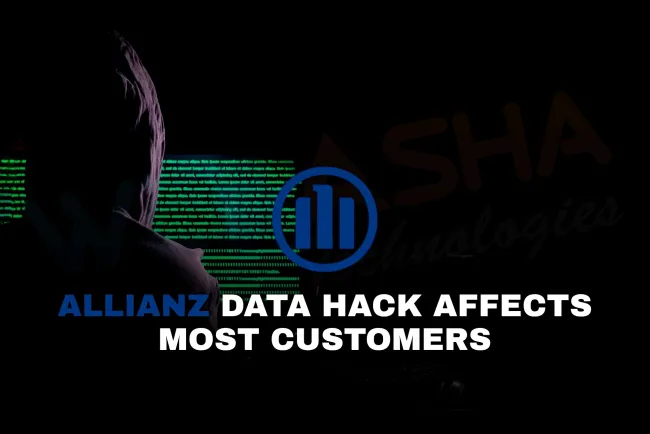What are the hidden weaknesses in AI SOC tools and how can organizations protect against them?
AI-powered SOC tools are widely used to detect and respond to cyber threats, but they have hidden vulnerabilities that many security teams overlook. These include poor data quality, model drift, lack of transparency, adversarial attack exposure, and vendor lock-in. This blog explains these weaknesses in plain language, with real-world examples and practical solutions that help IT and cybersecurity professionals understand and improve their AI SOC defenses.

Table of Contents
- What Are AI SOC Tools?
- Why Are AI SOC Tools Popular?
- Common Hidden Problems in AI SOC Tools
- Problems vs. Real-World Impact and Solution
- How to Defend Against These AI SOC Flaws
- Conclusion
- Frequently Asked Questions (FAQs)
What Are AI SOC Tools?
AI SOC (Security Operations Center) tools use artificial intelligence to help security teams detect and respond to cyber threats faster. These tools promise automated alerts, faster investigations, and fewer false alarms.
But here’s the truth—AI SOCs are not perfect. In fact, they have hidden flaws that attackers already know about, but many companies ignore. Let’s explore these blind spots so you can better protect your organization.
Why Are AI SOC Tools Popular?
Many companies are switching to AI-powered SOC platforms like:
-
Microsoft Sentinel
-
Google Chronicle
-
CrowdStrike Charlotte AI
-
IBM QRadar AI
-
Palo Alto Cortex XSIAM
They claim to save time by automatically detecting attacks, but they depend on data quality and training models. That’s where problems begin.
Common Hidden Problems in AI SOC Tools
Poor Data Quality = Missed Attacks
AI tools rely on good log data. If your logs are incomplete, broken, or missing, the tool might never see the attack happening.
Example: If your firewall logs aren’t feeding into the system, it won’t catch a port scanning attack.
Model Drift Makes Detection Weaker
AI models need regular updates. If the model hasn’t been retrained in weeks or months, it may miss new attack techniques.
Example: An attacker uses AI-generated phishing emails that look different from older patterns, and the outdated AI model fails to detect them.
Attackers Can Trick AI (Adversarial Attacks)
Some hackers know how to fool AI tools. They add fake or confusing data (called “noise”) to logs so the system marks the activity as safe.
Example: Mixing normal login events with malicious ones can trick the SOC into ignoring real threats.
Vendor Lock-In Creates Blind Spots
Many AI SOC tools only work well with their own ecosystem (like Microsoft for Microsoft, or Google for Google). This means external apps or cloud services may go unnoticed.
Example: A company using both AWS and Azure may not see AWS-related threats if their AI tool is tuned for Azure.
No Explainability = Confused Analysts
Many tools just give a score like “85/100 – High Risk” but don’t explain why. That makes it hard for human analysts to trust or investigate alerts properly.
Problems vs. Real-World Impact and Solution
| Weakness | What Can Go Wrong | How to Fix It |
|---|---|---|
| Bad data or broken logs | Missed threats, false negatives | Monitor log health and setup alerts |
| Model drift | New attacks go undetected | Regularly retrain AI models |
| Adversarial tricks | Hackers fool the AI with fake data | Test with simulated noise, adjust thresholds |
| Vendor lock-in | Partial visibility of hybrid/cloud systems | Choose tools that support multi-cloud logging |
| No transparency | Slows down analysts, trust issues | Use AI tools with explainable alert scoring |
How to Defend Against These AI SOC Flaws
1. Check Your Log Data
Make sure your AI SOC gets logs from:
-
Firewalls
-
Endpoints
-
Cloud platforms (Azure, AWS, GCP)
-
Email and user activity
2. Retrain the AI Models
Retrain every few weeks using:
-
New threat intelligence
-
Real-world attack simulations (Red Team)
3. Simulate Adversarial Attacks
Run tests where you try to:
-
Trick the AI with noisy data
-
Mimic real-world attacker behavior
4. Use Open and Flexible Tools
Don’t rely only on one vendor. Choose tools that support:
-
STIX/TAXII
-
OpenTelemetry
-
Syslog
-
Cloud-native integrations
5. Choose Transparent AI Tools
Ask vendors for AI tools that:
-
Show why an alert was triggered
-
Offer step-by-step reasoning (not just scores)
Conclusion
AI SOC tools are powerful, but they are not foolproof. They can:
-
Miss new types of attacks
-
Be tricked by smart hackers
-
Get confused without proper log data
That’s why you must treat them like assistants—not replacements for human analysts. Regular audits, retraining, and transparency are the keys to keeping your AI SOC sharp and effective.
FAQs
What is an AI SOC tool?
AI SOC tools use artificial intelligence to help detect and respond to cybersecurity threats in real-time by analyzing logs and user activity.
Why do companies use AI in SOC platforms?
AI helps reduce alert fatigue, speed up investigations, and improve detection of complex threats across large networks.
What is the biggest weakness of AI-based SOC tools?
One major issue is reliance on good quality data. Without complete and accurate logs, the AI can miss threats.
What is model drift in AI SOC tools?
Model drift occurs when the AI's understanding becomes outdated, causing it to misidentify or miss new types of cyber threats.
How can hackers trick AI SOC systems?
They use adversarial tactics like adding fake or noisy data to hide malicious actions from detection.
What is vendor lock-in in SOC tools?
It means the tool works best within its own ecosystem (e.g., Microsoft or Google), reducing visibility across other systems.
Are AI SOC alerts always accurate?
No, many tools generate false positives or negatives, especially if they're not updated regularly or if logs are missing.
How can I tell if an AI SOC alert is real?
Use tools that provide clear explanations for alerts instead of just scores, and involve human analysts for review.
What kind of data should be fed into an AI SOC?
Firewall logs, endpoint logs, cloud service logs, DNS queries, and user activity logs.
Can AI SOC tools detect phishing emails?
Some can, especially if integrated with email security systems and trained on phishing datasets.
What happens if logs are incomplete or missing?
The AI may miss threats entirely or make wrong decisions due to lack of visibility.
How often should AI models in SOC tools be retrained?
Ideally every few weeks, or after major threat intelligence updates.
What is explainable AI in SOC tools?
It’s when the tool shows how it reached a decision—like which log entries or events triggered an alert.
How can I test my AI SOC for weaknesses?
Use simulated attacks, red teaming, and noisy data injection to check its effectiveness.
Can AI SOC tools work across multiple cloud providers?
Yes, but only if they support multi-cloud integration. Some tools only monitor specific environments.
Is it safe to fully rely on AI SOC tools?
No, they should assist human analysts—not replace them.
How do I prevent AI SOC tools from being tricked?
Tune detection thresholds, add rule-based alerts, and retrain models with adversarial scenarios.
What’s the impact of vendor lock-in in AI SOCs?
You may miss threats from external systems or hybrid environments not supported by the vendor.
What does ‘false negative’ mean in AI detection?
It means the AI misses a real threat and doesn’t alert you about it.
Do open-source AI SOC tools exist?
Yes, options like Wazuh and Elastic Security are open-source and can be enhanced with AI.
How can I improve log quality for my SOC?
Set up automated log health checks and alerts for missing or corrupted log files.
What is an adversarial AI attack in cybersecurity?
It’s when attackers intentionally input misleading data to confuse AI models and avoid detection.
What are some popular AI SOC platforms?
Microsoft Sentinel, Google Chronicle, IBM QRadar, CrowdStrike Falcon, and Palo Alto Cortex XSIAM.
How can I detect model drift in AI SOCs?
Monitor for decreased detection accuracy or increased false positives over time.
Are AI SOC tools good at detecting insider threats?
Yes, but only if properly trained on behavior patterns and updated regularly.
What is alert fatigue and how does AI help?
Alert fatigue is when analysts get too many alerts. AI helps by filtering and prioritizing high-risk events.
Can AI SOC tools be used in small businesses?
Yes, some cloud-based solutions are affordable and scalable for small teams.
What’s the difference between traditional and AI-powered SOCs?
Traditional SOCs rely on rule-based detection, while AI-powered ones use machine learning to find hidden threats.
Should I trust AI SOC tools blindly?
No. Always combine them with expert human analysis and regular audits.
Can I build a custom AI SOC?
Yes, with open-source tools and ML models, but it requires technical expertise and maintenance.














![Top 10 Ethical Hackers in the World [2025]](https://www.webasha.com/blog/uploads/images/202408/image_100x75_66c2f983c207b.webp)








